Charlotta Hauksdóttir is a Palo Alto-based mixed media artist whose works incorporate the stunning natural landscapes of Iceland, her native country. As Hauksdóttir’s awareness of climate change has developed, her works have evolved along with it. This is the story of that evolution.
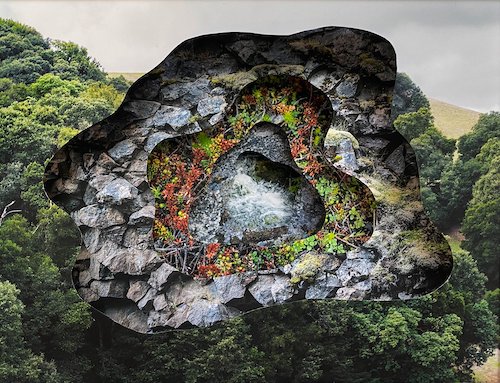
Enter Here IV, by Charlotta Hauksdóttir
Hauksdóttir has a deep and abiding love for Iceland’s “magical” landscapes with their broad vistas, glowful lighting, varied terrain and ever-changing weather. As a child she spent summers camping, picking blueberries, and recreating outdoors with family and friends, forming deep bonds with people and the land.
After leaving Iceland to study photography at the San Francisco Art Institute, a bout of homesickness led her to put together sets of photographs, “Dreamscapes”, that reflected her memory of the land she loved. Imperfections in our memory, and our movement through the landscapes, are represented by gaps between photos and selective blurring. The photographs are not objective mirrors of landscapes, but instead reflect our perception of places. People are represented in the art, and the connection between people and nature, even though we are not visible.

Sharp Edges, by Charlotta Hauksdóttir
It had long been a dream of Hauksdóttir to study in San Francisco, but each time she traveled back to Iceland, even the moss-covered lava fields by the airport reminded her how much she missed her home. Her art diverged from the “fairy tale” dreamscapes to a more immersive format that could almost envelop the viewer. The human-scale art, placed at eye level, allows a viewer to look down by their feet, or up by the horizon, and see what you might see if you were there. Seams between the photos are visible to remind us that perception is not reality.
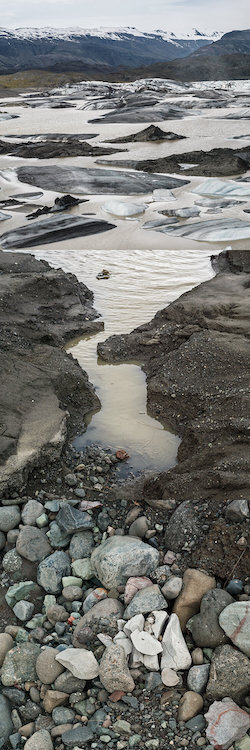
Walk on Water, by Charlotta Hauksdóttir
As her children grew, her work switched to focus more on family and life changes, with the themes of time evolving and nostalgia for moments in time coming to the fore. But in 2016 she turned back to landscapes, this time feeling an urgency “not to assemble the landscape, but to disperse it in pieces”. She wasn’t sure where this impetus was coming from, or what it would look like. She knew only that the dispersal should be a meaningful pattern, something organic. It took a lot of trial and error until she found a technique that resonated, cutting up her photographs and layering them. This was a destructive act for her, as she described it, “physically cutting up these memories”. But Iceland was changing, and it felt right.
Hauksdóttir began with a fingerprint pattern, here rendered in black velvet, that reminds viewers that we are more than passive observers of nature.
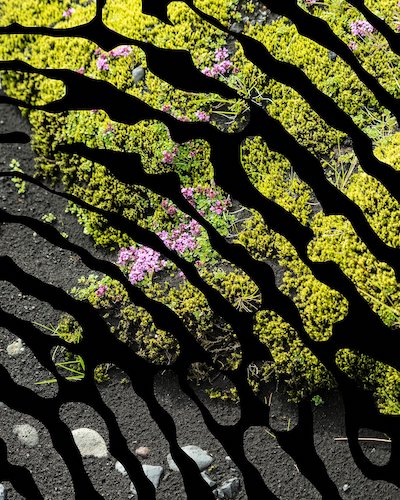
Impression XXV, by Charlotta Hauksdóttir
She also employed a cut-out pattern of retinal veins, conveying “our unwillingness to admit or see what’s happening in nature”.
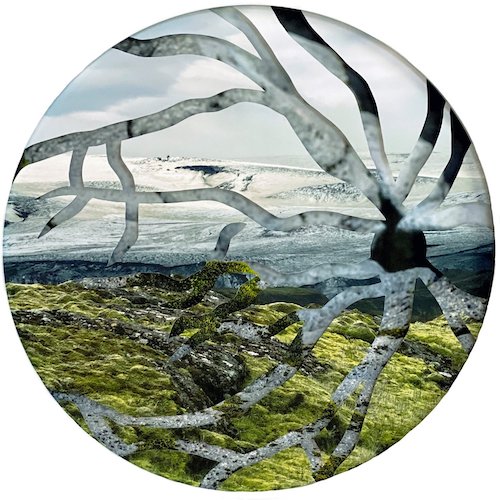
Imperception IV, by Charlotta Hauksdóttir
In other works gaps in the terrain, often where snow or ice might have been, are filled with texts about global warming.
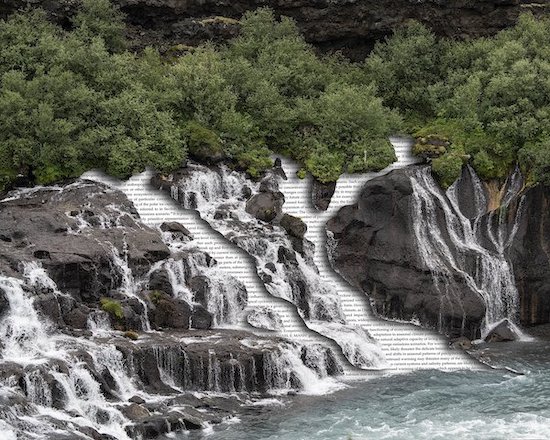
Erosion VII, by Charlotta Hauksdóttir
Hauksdóttir recalls seeing Iceland change through her twenty years of photographing it. “If you look at the glacier in this photo, I took that in 2014. I went back in 2019, and the glacier was so much smaller, with pieces coming off as I watched. The erosion of nature that I have witnessed is represented in these works.”
A series of topographic works physically removes pieces of the landscape, giving a sense of time passing as erosion happens.

Topography Study XV, by Charlotta Hauksdóttir
“People often visualize topography,” Hauksdóttir observes, “with the pieces being built up from the base. But in mine they are cut away from the surface, showing the wearing away of our natural environment.” In an upcoming exhibition in Berkeley, viewers will themselves be taking away some of these pieces, reinforcing our involvement in the environmental degradation we are seeing.
Hauksdóttir’s work continues to evolve. With the storms of last year, she incorporated both the destructive force of the winds and our ability to repair by weaving together pictures bound around sticks. This work is more hopeful in that it not only cuts things up but also binds things together.
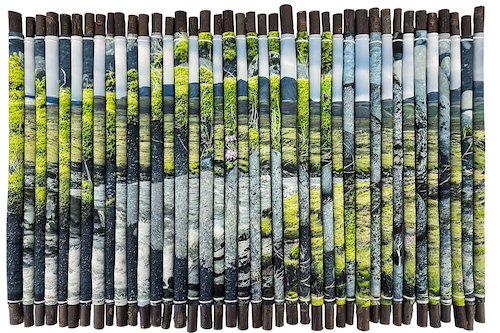
Reclamation IV, by Charlotta Hauksdóttir
This year, after many walks with her dog looking at plants growing in the smallest of sidewalk cracks, she developed new works that emphasize the resilience of nature in the face of the changes we are seeing.
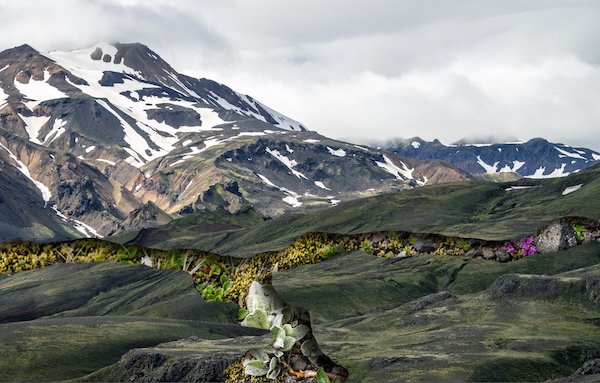
Resurgence III, by Charlotta Hauksdóttir
“Sometimes I get criticism that my works are too beautiful, that they do not show enough of the destruction from climate change, or the harm that we are doing to the planet. But at the same time, it is important to draw viewers in. I find that people appreciate the works even more when they understand what they are about.”
Art can help us to connect with our feelings. Even Hauksdóttir does not know what her works are about until after she has created them and reflected upon them. We need to bring both our hearts and our minds to the environmental challenges we are facing. It is not enough to know without caring, or to care without knowing. Art that incorporates climate change themes can help us to reflect more deeply on the scale of the change, the destruction, the uncertainty, and the resilience that we are living with as the planet warms.
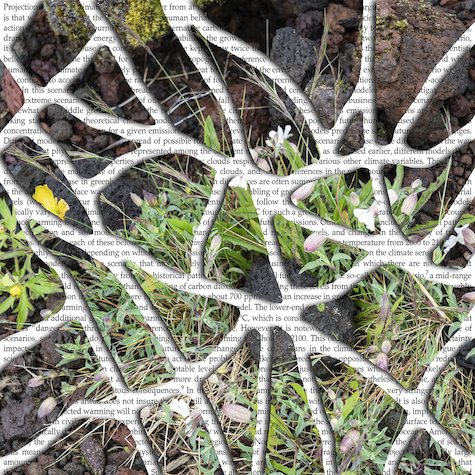
Indentation I, by Charlotta Hauksdóttir
You can see more of Hauksdóttir’s work on her website. She has a studio in Palo Alto’s Cubberley Community Center. She also has multiple pieces up at the Garvey Simon Gallery in San Anselmo, and will soon have several on display at 120710 in Berkeley. I hope many of you will take a look.
Happy Thanksgiving to everyone!
Current Climate Data
Global impacts (October 2023), US impacts (October 2023), CO2 metric, Climate dashboard
Globally, October 2023 was the warmest October in the 174-year NOAA record. The year-to-date (January–October) global surface temperature ranked as the warmest such period on record. October 2023 marked the fifth consecutive month of record-warm global temperatures. According to NCEI’s Global Annual Temperature Outlook and data through October, there is a greater than 99% probability that 2023 will rank as the warmest year on record.
Comment Guidelines
I hope that your contributions will be an important part of this blog. To keep the discussion productive, please adhere to these guidelines or your comment may be edited or removed.
- Avoid disrespectful, disparaging, snide, angry, or ad hominem comments.
- Stay fact-based and refer to reputable sources.
- Stay on topic.
- In general, maintain this as a welcoming space for all readers.



